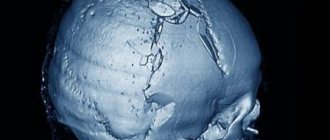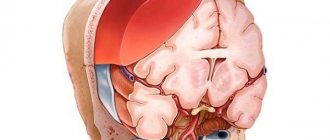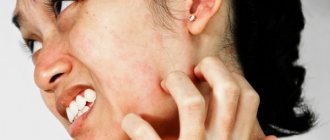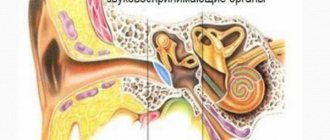A sympatho-adrenal crisis, also called a panic attack, is one of the manifestations of VSD (vegetative-vascular dystonia) of the hypertensive type.
This condition is not a disease, but a condition that manifests itself in the form of an acute attack, which is accompanied by an increase in heart rate, chest pain, a sharp rise in blood pressure, as well as an emotional feeling of fear.
The most common time for a crisis to occur is the second half of the day or night.
This fact is explained simply - during the day the body accumulates both physical and emotional fatigue, which can cause a panic attack.
Read more about panic attacks in our materials:
What happens during a crisis
Let's take a closer look at what happens during the onset of a sympatho-adrenal crisis.
Physical manifestations: a headache occurs, breathing becomes difficult, a feeling of lack of air appears, trembling occurs throughout the body, the sensitivity of the skin may be impaired, even a light touch causes pain, the limbs become cold, the body temperature rises.
In addition, as mentioned above, the heart rate increases and blood pressure rises.
At the time of a sympathoadrenal crisis, the human body experiences an overdose of adrenaline, which is released into the blood in a very significant volume.
Emotional manifestations: the patient develops a feeling of fear, often the person experiences fear of imminent death, unreasonable horror, ceases to trust others and believes that he is in danger.
As a rule, the duration of a crisis does not exceed 1-2 hours , although some patients claim that in fact a panic attack lasts much longer - up to 8 hours. However, even in such a short period, the body is subjected to a colossal test and experiences great stress.
The end of the attack occurs suddenly and is characterized by a feeling of powerlessness and weakness.
The intense work of the kidneys during a crisis results in copious urination, and the urine becomes very light.
After a crisis, it is recommended to remain calm, try to relax or distract yourself with some pleasant activity. This is necessary so that thoughts about the experience do not provoke a second attack.
At the moment, medical practice shows that the treatment of sympathoadrenal crises is quite successful.
Modern techniques and medications, selected by a professional doctor, have a positive effect and help cope with this condition. However, without the desire of the patient himself to overcome the panic state, the specialist will not be able to help fully.
Therefore, only through interaction between the doctor and the patient can the maximum effect be achieved and individual factors that provoke the development of a sympatho-adrenal crisis be overcome.
Notes
- World Health Organization.
F4 Neurotic, stress-related, and somatoform disorders // International Classification of Diseases (10th revision). Class V: Mental and behavioral disorders (F00-F99) (adapted for use in the Russian Federation). - Rostov-on-Don: Phoenix, 1999. - P. 175-176. — ISBN 5-86727-005-8. - ↑ 123
Goloshchapov A., 2021, Chapter 6. Panic disorder (panic attacks) 6.1. What is panic disorder? - Goloshchapov A., 2021, 6.2. Specific strategies for working with panic disorder 6.1. Ways to survive a panic attack.
- Shear MK, Brown TA, Barlow DH, Money R., Sholomskas DE, Woods SW, Gorman JM, Papp LA
Multicenter collaborative panic disorder severity scale. (English) // The American Journal Of Psychiatry. - 1997. - November (vol. 154, no. 11). — P. 1571—1575. - doi:10.1176/ajp.154.11.1571. - PMID 9356566. [] - https://goodmedicine.org.uk/files/panic,%20assessment%20pdss.pdf
- APA Diagnostic Classification DSM-IV-TR
- ↑ 1 2 3 Kasper Z., Zohar J., Stein D.
Decision making in psychopharmacotherapy / Transl. from English V. Shtengelov. - Kyiv: Sfera, 2006. - 136 p. — ISBN 966-8782-24-0. - ↑ 123
Pharmacotherapy in neurology and psychiatry: [Trans. from English] / Ed. S. D. Enna and J. T. Coyle. - Moscow: LLC: "Medical Information Agency", 2007. - 800 pp.: ill. With. — 4000 copies. — ISBN 5-89481-501-0. - Kaczkurkin AN, Foa EB
Cognitive-behavioral therapy for anxiety disorders: an update on the empirical evidence. (English) // Dialogues In Clinical Neuroscience. — 2015. — September (vol. 17, no. 3). - P. 337-346. — PMID 26487814. [] - ↑ 1 2 Gorodnichev A.V.
Current trends in the treatment of anxiety disorders: from scientific data to clinical recommendations // Biological methods of treatment of mental disorders (evidence-based medicine - clinical practice) / Ed. S.N. Mosolova. - Moscow: Publishing House "Social and Political Thought", 2012. - P. 643-668. — 1080 s. — 1000 copies. — ISBN 978-5-91579-075-8. - Hedman E., Ljótsson B., Rück C., Bergström J., Andersson G., Kaldo V., Jansson L., Andersson E., Andersson E., Blom K., El Alaoui S., Falk L., Ivarsson J., Nasri B., Rydh S., Lindefors N.
Effectiveness of internet-based cognitive behavior therapy for panic disorder in routine psychiatric care. (English) // Acta Psychiatrica Scandinavica. — 2013. — December (vol. 128, no. 6). - P. 457-467. - doi:10.1111/acps.12079. — PMID 23406572. [] - Kholmogorova A. B., Garanyan N. G., Nikitina I. V., Pugovkina O. D.
Scientific research into the process of psychotherapy and its effectiveness: the current state of the problem. Part 1 // Social and clinical psychiatry. - 2009. - T. XIX, No. 3. - P. 92-100. - Otto MW, Hong JJ, Safren SA
Benzodiazepine discontinuation difficulties in panic disorder: conceptual model and outcome for cognitive-behavior therapy. (English) // Current Pharmaceutical Design. - 2002. - Vol. 8, no. 1. - P. 75-80. - doi:10.2174/1381612023396726. — PMID 11812251. [] - Martha Davis, Elizabeth Robbins Eshelman, Matthew McKay.
The relaxation & stress reduction workbook. - Oakland, USA: New Harbiner Publications Inc., 2008. - 294 p. — ISBN 1-57224-214-0. - ↑ 1 2 3 Garanyan N. G.
Practical aspects of cognitive psychotherapy // Moscow Psychotherapeutic Journal. - 1996. - No. 3.
Causes of crises
The very concept of “crisis” in the name of the condition under consideration indicates the presence of an extreme situation for the body, which leads to a negative reaction. What reasons can provoke sympathoadrenal crises?
These can be either internal psychological or physical problems, or external factors that cause emotional disorders.
Internal psychological reasons
People who are used to suppressing their emotions often suffer from panic attacks.
They cannot allow themselves to fully experience any shocks, both positive and negative, and as a result live in a state of stress.
However, emotions accumulated over a long period can negatively affect not only a person’s moral state, but also the body, finding a way out in a sympatho-adrenal attack.
Bad habits can also be included in this category of influencing factors.
Dangerous, unpredictable and difficult to predict - hepatic encephalopathy. What methods of diagnosis and treatment does modern medicine offer? Fruitless verbosity or resonant thinking. Real life examples of violations. Which brain centers are affected in such cases.
Internal physical reasons
These include various health disorders that can provoke a sympatho-adrenal crisis.
Among them:
- a neoplasm (tumor) in the adrenal medulla, which contributes to the release of a high volume of adrenaline into the blood (and regardless of the psychological state of the patient);
- disorders that increase stimulation of the central part of the sympathetic system in the spinal cord (tumor of the spinal cord, spine, ischemia);
- the presence of pathological impulses of areas of the brain associated with the sympathetic system and hypothalamus (similar to epileptic seizures);
- the presence of a neuroinfection, as well as a past illness associated with a neuroinfection;
- suffered traumatic brain injuries;
- disruption of the normal balance of hormones in the body;
- some disturbances in the functioning of the cardiovascular system;
- some diseases of the gastrointestinal tract and digestive system.
External factors
First of all, this category of reasons includes emotional stress arising as a result of any events affecting the patient.
They can be both positive and negative (more often they provoke a panic attack).
With a strong psychological shock, the brain gives the adrenal glands a command to release large amounts of adrenaline, which leads to a sympatho-adrenal crisis.
In addition, an external factor may be the tendency of close relatives to have panic attacks, which can cause a hereditary predisposition.
It should be noted that in one patient a sympatho-adrenal crisis can be provoked by different factors, and they will not always be the same during repeated attacks.
Diagnostic methods
Determining the presence of a vegetative crisis is quite difficult even for an experienced specialist. To confirm the diagnosis, a comprehensive diagnosis is necessary, which includes a medical examination, assessment of reflex functions, ECG, pulse check, blood pressure, etc. Only after receiving the results can we make assumptions about the presence of a vegetative crisis in the patient. The disease can be accurately diagnosed only when the attack is over by excluding the following ailments and conditions:
- cardiac dysfunction - requires 24-hour cardiac monitoring, stress ECG, and cardiac ultrasound;
- stroke, brain tumors - CT and MRI are required;
- vascular crisis - encephalography and CT are performed;
- bronchial asthma – it is necessary to carry out breathing tests and skin tests to determine allergies;
- internal blood loss - you need an ultrasound of the peritoneal and pelvic organs;
- hypertensive vegetative crisis - CT or MRI is performed;
- mental disorders - examined by a psychiatrist.
When all of the listed pathologies are excluded and it is determined that the peak of the crisis occurs 10 minutes after the onset, and in addition an anxious feeling or deep-seated fear appears, the patient is diagnosed with a vegetative-vascular crisis.
In some cases, a similar diagnosis is given to children. The cause of this phenomenon may be psychological trauma or stress. As a rule, the development of a vegetative crisis in childhood is caused by quarrels in the family.
Characteristic symptoms and signs
The sympatho-adrenal crisis develops quite rapidly, and, as a rule, the symptoms appear in aggregate.
Sympathetic adrenal crisis has the following characteristic symptoms:
- difficulty breathing, feeling of heaviness, tightness in the chest;
- feeling of cold or heat, the appearance of tremors of the limbs;
- paleness of the skin;
- a sharp increase in blood pressure, vasospasm;
- headache, throbbing sensation;
- increased heart rate, arrhythmia;
- dry mouth;
- emotional feeling of groundless horror, fear of death.
It should be noted that even the manifestation of symptoms can provoke a relapse of a sympatho-adrenal crisis, so it is very important to try to keep yourself “in control” during the onset of an attack.
Treatment of sympatho-adrenal crisis
The treatment process usually combines the use of medications and psychotherapy . Preventive measures and the patient’s compliance with certain rules of life are also important.
Emergency assistance during a seizure
Usually, emergency care for a sympathoadrenal crisis is not required, because when an attack approaches, the patient can cope with it independently, taking control of his psycho-emotional state.
However, in difficult cases, it is possible to use sedatives , which quickly relieve the symptoms of a crisis, or other effects according to the symptoms (for example, using a drug to lower blood pressure).
Drug treatment
For treatment at the first symptoms of sympatho-adrenal crisis, the following groups of drugs are used :
- Tranquilizers. For example, alprazolam, phenazepam. Used to reduce the excitability of the central nervous system (CNS). Drugs in this group are also prescribed for the prevention of attacks. However, you should know that tranquilizers do not eliminate the cause of the crisis, but only relieve symptoms, so long-term use of such drugs is not recommended. As a rule, they are prescribed at the beginning of treatment, before the causes of panic attacks are identified.
- Beta blockers. Drugs in this group neutralize the effect of adrenaline, therefore they are used to stop an attack or prevent a crisis when the first symptoms appear. Such drugs include atenolol, anaprilin.
- Antidepressants (Paxil, Cipralex). To obtain a positive effect, such drugs are recommended to be used for a long period (6-12 months). However, after discontinuation of antidepressants, a relapse of sympathoadrenal crisis is possible.
- Herbal medicines that have a sedative effect (sage, motherwort, valerian and others). Used as an alternative to complex sedatives. A positive effect is achieved after taking a course lasting from 6 to 12 months.
It should be noted that in no case should you choose medications on your own; only a qualified doctor should prescribe any drugs to overcome a sympatho-adrenal crisis.
Psychotherapeutic treatment
The patient’s work with a psychotherapist allows one to achieve good results in overcoming panic attacks.
An experienced doctor will help identify the causes of crises, and then work through and neutralize them together with the patient.
At the moment, there are several methods that can be used to solve the problem of sympatho-adrenal crises, so it is possible to select a specific treatment technology individually for each specific case.
Urgent Care
To relieve an attack, breathing exercises are most effective. First, you need to take a slow, as deep breath as possible, hold your breath for 3-5 counts, and exhale smoothly, stretched out as long as possible. You need to carry out at least 15 such breathing cycles. Then close your eyes, relax all your muscles and count the duration of normal inhalations and exhalations, trying to make the exhalation twice as long as the inhalation.
Watch the video about breathing exercises for panic attacks:
Some patients find hot peppermint or chamomile tea, cold water washing, and anxiety self-restraint techniques helpful. Its essence is that in response to any thought that comes to you about a bad outcome (the possibility of death, serious illness, madness), you need to mentally say “STOP”.
An elastic band worn on the wrist can also act as a limiter. At the first sign of anxiety, you should pull it back slightly and let it go. It is best to first work on all these techniques with a psychotherapist.
Prevention measures
Factors such as diet, daily routine, and physical activity are not decisive for overcoming attacks. However, following simple preventive measures will reduce the frequency of crises and soften their course.
Prevention measures include:
- walks in the fresh air, moderate but regular physical activity;
- good sleep;
- proper nutrition, taking the necessary vitamins and minerals, it is advisable to divide food into smaller portions, but increase the number of meals;
- refusal of alcoholic drinks and energy drinks;
- reduce the time spent watching TV and reading news on the Internet to reduce the risk of negative emotions;
- It is recommended to avoid stressful situations if possible.
Other perivascular crises
CSF crisis, hemolytic crisis, vagoinsular crisis, and vegetative-vascular paroxysm have similar symptoms
However, the causes of all these attacks are different, therefore treatment is selected individually in each case.
That is why, if alarming symptoms appear, you should consult a doctor who, after conducting diagnostic measures, will be able to accurately determine the type of crisis and prescribe the necessary course of treatment.









